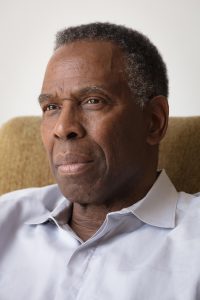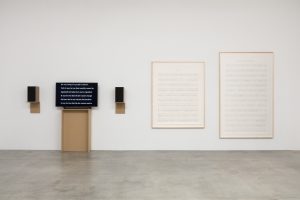As a continuation of our work for the Getty Research Institute’s African American Art History Initiative, Dr. Bridget Cooks and I conducted a series of oral history interviews with the conceptual artist Charles Gaines. This interview was the first of several exploring the lives and work of Los Angeles-based artists, and celebrates Gaines’s extraordinary artistic contributions.

Charles Gaines is an artist specializing in conceptual art, as well as a professor of art at California Institute of the Arts. Gaines was born in South Carolina in 1944, but grew up in Newark, New Jersey. He attended Arts High School in Newark, graduated from Jersey City State College in 1966, and earned an MFA from the School of Art and Design at the Rochester Institute of Technology in 1967. Beginning in 1967, he taught at several colleges, including Mississippi Valley State College, Fresno State University, and California Institute of the Arts. Gaines has written several academic texts, including “Theater of Refusal: Black Art and Mainstream Criticism” in 1993 and “Reconsidering Metaphor/Metonymy: Art and the Suppression of Thought” in 2009. His influential artwork includes Manifesto Series, Numbers and Trees, and Sound Text; and he exhibited at the Venice Biennale in 2007 and 2015. Gaines is the recipient of several awards, including Guggenheim Fellowship in 2013 and REDCAT Award in 2018. Find this interview and all our oral histories from the search feature on our home page. You can search by name, key word, and several other criteria.
Hearing about Charles Gaines’s upbringing was especially helpful in framing his approaches to art. For example, he spoke about his mother’s influence on his life–particularly her musical inclinations. Though Gaines concentrated his early artistic studies on the visual arts, he also had a passion for music, eventually becoming a professional drummer. This connection to musicality and music theory features prominently in his conceptual works like Snake River and Manifestos. Indeed, in his Manifestos Series, Gaines turned the text of political manifestos into musical compositions based on a system he devised. He recalled, “Unconsciously, I began thinking about music as a kind of mathematics and this connection with text and language; I began to see the connection to language and systems.”

speakers, hanging speaker shelves. Photograph by Frederik Nilsen.
Further, Gaines shared about his exploration of conceptual work in the 1970s, and his consequential transition from an abstract painter to a conceptual artist:
Well as I said, those big abstraction paintings turned into these process-oriented works, and so that work demonstrated an interest in a systematic approach. It was a part of my research. I was looking for an alternate way of making work that was not based upon the creative imagination, was not based upon subjective expression.
This transition period also coincided with an eighteen-month sabbatical from teaching at Fresno State University from 1974 to 1975, when Gaines, his wife, and infant son moved to New York to explore his professional art practice. He recalled of the conceptual artists he met there:
But I did at that time, during that time in New York, become much more familiar with conceptualists, with what the conceptualists were doing. At that time, it provided a context for me. It was just before I started working with numbers but I was working with systems already, and so I felt that it’s true that, of anybody, my work, the language of my work fits best with those conceptualists.
Another major theme in Gaines’s interviews was his many years teaching art at colleges across the country, including the challenges of teaching at what he deemed conservative institutions. Despite these challenges, Gaines always looked for ways to mentor his students by not only helping them improve the quality of their work, but also by sharing his own insights into how to navigate the art world. He explained:
The thing I would always give my students advice about is that you can’t control career. That’s something that you shouldn’t even be thinking about. You should only think about the work, and you should also think about exhibiting the work, which I think is different from a career. You need to show people the work, so you make the work and try to get people to see it. In that process, something might happen, you can’t make it happen. In almost every story about how careers get kicked off, it’s because you happen to be at a right place at the right time, and somebody who matters notices something, and then things sort of roll into place…Ultimately, it’s the work that’s going to get you the exposure.
In addition to his own works and teaching career, Gaines has also made many important contributions to the art world through his theoretical writing and curation of exhibitions. In 1993, he co-curated Theater of Refusal: Black Art and Mainstream Criticism with Catherine Lord at the University of California, Irvine in 1993. This show, and Gaines’s catalog piece, explored racism in the art world by displaying Black artists’ work alongside reviews from (largely white) art critics, and questioned how and why they misread this work. Of this important exhibition, Gaines explained:
Well, I chose artists who were actively producing in the art world, and known to people. In a couple of cases, I showed a couple of people who were at an early part of their career, like Renée Green, for example, just started her career. But there were other people like Lorna Simpson and Fred Wilson, Adrian Piper, were completely well-known. The fact that they’re well-known artists was important to me because it allowed me to underscore this point that I was making: that is that there’s not much writing on the work of artists, even if they’re well known. The writing that there is [is] marginalized around the idea of race. The writers who wrote about [them] often thought they were writing positively about the work. They didn’t think that the way they approached the work was, in fact, marginalizing.
To learn more about Charles Gaines’s life and work, check out his oral history interview! Find this interview and all our oral histories from the search feature on our home page. You can search by name, key word, and several other criteria.